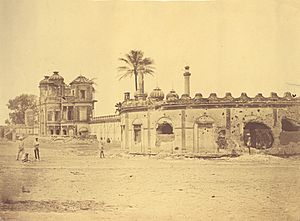John Dunlay facts for kids
Quick facts for kids
John Dunlea
|
|
|---|---|

Secundra Bagh showing the first breach of the walls
|
|
| Born | 1831 Douglas, County Cork |
| Died | 17 October 1890 (aged 58–59) Cork |
| Buried |
St Joseph's Cemetery, Cork
|
| Allegiance | |
| Service/ |
|
| Rank | Private |
| Unit | 93rd Regiment of Foot |
| Battles/wars | Indian Mutiny |
| Awards | Victoria Cross |
John Dunlea (1831 – 17 October 1890) was a brave Irish soldier. He is famous for receiving the Victoria Cross. This is the highest award for bravery a soldier can get. It is given to British and Commonwealth forces.
Contents
Who Was John Dunlea?
John Dunlea was born in 1831 in Douglas, County Cork, Ireland. He joined the British Army and became a Lance-Corporal. He served in the 93rd Regiment of Foot. This regiment later became known as The Argyll and Sutherland Highlanders.
The Victoria Cross
The Victoria Cross (VC) is a very special award. It is given for extreme bravery. Soldiers receive it for showing amazing courage in battle. John Dunlea earned this high honor.
A Brave Act at Secundra Bagh
John Dunlea showed great bravery on 16 November 1857. This happened during the Indian Mutiny in Lucknow, India. He was about 26 years old at the time.
He was the first soldier from his regiment to enter a damaged wall. This wall was part of a place called Secundra Bagh. He bravely supported Captain Burroughs. They faced many enemy soldiers together.
Lance-Corporal J. Dunlay. Date of Act of Bravery, 16th November, 1857
For being the first man, now surviving, of the Regiment, who, on the 16th November, 1857 entered one of the breaches in the Secundra Bagh, at Lucknow, with Captain Burroughs, whom he most gallantly supported against superior numbers.
Elected by the private soldiers of the Regiment.
What Was the Indian Mutiny?
The Indian Mutiny was a big uprising in India. It happened between 1857 and 1859. It was a major conflict against the rule of the British East India Company. Many soldiers and civilians were involved.
Secundra Bagh Explained
Secundra Bagh was a large villa and country estate. It was located on the edge of Lucknow, India. It played an important role in the fighting during the Indian Mutiny.
Later Life
After his brave service, John Dunlea returned home. He passed away in Cork, Ireland. He died on 17 October 1890. He was buried in St Joseph's Cemetery in Cork.

